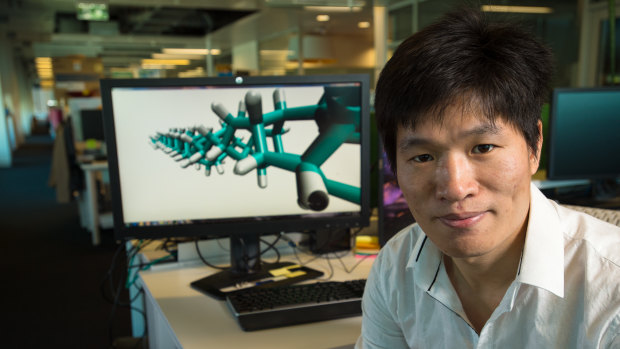This was published 4 years ago
Diamonds are a scientist's best friend for cutting-edge energy storage
By Stuart Layt
Queensland researchers have developed a method of capturing and storing energy at three times the rate of standard lithium-ion batteries, powered by diamonds.
The diamond nanothreads developed by QUT researchers are extremely thin filaments of carbon - so fine they are considered one-dimensional for engineering purposes, but also very strong for their size and weight.

QUT's Dr Haifei Zhan with a molecular model of the diamond nanothread.Credit: Anthony Weate, QUT
Haifei Zhan, from the QUT Centre for Materials Science said the research team has found a way to twist bundles of these diamond filaments so that they mechanically stored energy.
“Similar to a compressed coil or children’s wind-up toy, energy can be released as the twisted bundle unravels,” Dr Zhan said.
“If you can make a system to control the power supplied by the nanothread bundle, it would be a safer and more stable energy-storage solution for many applications.”
Previous research on carbon nanotubes, which are a similar material to these diamond filaments, has found they can lift 50,000 times their own weight.
Dr Zhan estimates the filaments they’ve developed can be twisted to store energy at a rate of 1.76 megajoules per kilogram - up to five orders higher than a conventional steel spring, and up to three times higher than existing lithium-ion batteries.
Diamond filaments bundled to form a “mechanical battery” would also be safer than chemical batteries for many applications, because they don’t leak and respond to changes in temperature well.
“Mechanical energy storage systems don’t have these risks so make them more suited to potential applications within the human body,” Dr Zhan said.
“Carbon nanothread bundles could be made into twist-spun yarn-based artificial muscles that respond to electrical, chemical or photonic excitations.”
Long before anyone gets fitted for bionic super-arms, however, the researchers need to do more work to develop a suitable control mechanism.
They are currently working on that project to develop a proof-of-concept over the next two-to-three years, alongside colleagues in Agency for Science, Technology and Research in Singapore, and the National University of Singapore.
Dr Zhan said in additional to bionics, the applications of the technology were potentially wider than current chemical batteries, because it would be more adaptable to different uses.
“The benefits for aerospace applications are obvious. If we can reduce the weight of a system, we can significantly reduce its fuel requirements and costs," he said.
“The nanothread bundles could be used in next-generation power transmission lines, aerospace electronics, batteries, intelligent textiles and structural composites such as building materials.”
The research has been published in the journal Nature Communications.